Deck 14: The Brain and Cranial Nerves
Question
Question
Question
Question
Question
Question
Question
Question
Question
Question
Question
Question
Question
Question
Question
Question
Question
Question
Question
Question
Question
Question
Question
Question
Question
Question
Question
Question
Question
Question
Question
Question
Question
Question
Question
Question
Question
Question
Question
Question
Question
Question
Question
Question
Question
Question
Question
Question
Question
Question
Question
Question
Question
Question
Question
Question
Question
Question
Question
Question
Question
Question
Question
Question
Question
Question
Question
Question
Question
Question
Question
Question

Unlock Deck
Sign up to unlock the cards in this deck!
Unlock Deck
Unlock Deck
1/72
Play
Full screen (f)
Deck 14: The Brain and Cranial Nerves
1
Which of the following brain structures consists of the thalamus,hypothalamus and epithalamus?
A)Cerebellum
B)Brain stem
C)Cerebrum
D)Diencephalon
E)Dura mater
A)Cerebellum
B)Brain stem
C)Cerebrum
D)Diencephalon
E)Dura mater
D
2
Which region of the brain contains the pontine respiratory group that help control breathing?
A)Medulla oblongata
B)Midbrain
C)Pons
D)Thalamus
E)Cerebellum
A)Medulla oblongata
B)Midbrain
C)Pons
D)Thalamus
E)Cerebellum
C
3
A lesion on which structure would affect the acoustic "startle reflex" ?
A)Superior colliculus
B)Inferior colliculus
C)Pontine nucleus
D)Medial lemniscus
E)Inferior olivary nucleus
A)Superior colliculus
B)Inferior colliculus
C)Pontine nucleus
D)Medial lemniscus
E)Inferior olivary nucleus
B
4
Cerebrospinal fluid exits the brain through a single [dropdown 1] aperture and paired [dropdown 2] apertures in the roof of the [dropdown 3] ventricle.
Dropdown 1&2 choices:
medial
lateral
interventricular
Dropdown 3 choices:
Lateral
Third
Fourth
Dropdown 1&2 choices:
medial
lateral
interventricular
Dropdown 3 choices:
Lateral
Third
Fourth

Unlock Deck
Unlock for access to all 72 flashcards in this deck.
Unlock Deck
k this deck
5
Which portion of the ventricular system is located in the cerebral hemisphere?
A)Lateral ventricle
B)aqueduct of the midbrain
C)Fourth ventricle
D)Third ventricle
A)Lateral ventricle
B)aqueduct of the midbrain
C)Fourth ventricle
D)Third ventricle

Unlock Deck
Unlock for access to all 72 flashcards in this deck.
Unlock Deck
k this deck
6
The blood brain barrier (BBB)is formed from processes of many [dropdown 1].Many substances cannot enter the BBB due to the [dropdown 2].
Dropdown 1 choices:
astrocytes
ependymal cells
oligodendrocytes
Schwann cells
Dropdown 2 choices:
Gap junctions
Tight junctions
Desmosomes
Adherens
Dropdown 1 choices:
astrocytes
ependymal cells
oligodendrocytes
Schwann cells
Dropdown 2 choices:
Gap junctions
Tight junctions
Desmosomes
Adherens

Unlock Deck
Unlock for access to all 72 flashcards in this deck.
Unlock Deck
k this deck
7
Folia are to ___ ,as arbor vitae are to ___.
A)gyri;tracts
B)nuclei;lobes
C)sulci;septum pellucidum
D)fissures;ventricles
E)lobes;hemispheres
A)gyri;tracts
B)nuclei;lobes
C)sulci;septum pellucidum
D)fissures;ventricles
E)lobes;hemispheres

Unlock Deck
Unlock for access to all 72 flashcards in this deck.
Unlock Deck
k this deck
8
The [dropdown 1] releases the neurotransmitter [dropdown 2],which is active in pleasurable experiences and regulation of muscle tone.
dropdown 1choices:
substantia nigra
inferior olivary nucleus
cuneate nucleus
gracile nucleus
dropdown 2 choices:
epinephrine
acetylcholine
norepinephrine
gABA
dopamine
dropdown 1choices:
substantia nigra
inferior olivary nucleus
cuneate nucleus
gracile nucleus
dropdown 2 choices:
epinephrine
acetylcholine
norepinephrine
gABA
dopamine

Unlock Deck
Unlock for access to all 72 flashcards in this deck.
Unlock Deck
k this deck
9
The periosteal and meningeal layer are part of the
A)Spinal dura mater
B)Cranial dura mater
C)Spinal arachnoid mater
D)Cranial arachnoid mater
E)Cranial pia mater
A)Spinal dura mater
B)Cranial dura mater
C)Spinal arachnoid mater
D)Cranial arachnoid mater
E)Cranial pia mater

Unlock Deck
Unlock for access to all 72 flashcards in this deck.
Unlock Deck
k this deck
10
[___] is found in the medulla oblongata and receives sensory information associated with touch,pressure and vibration.
Dropdown choices:
Gracile nucleus
Inferior olivary nucleus
Pontine nucleus
Red nucleus
Substantia nigra
Dropdown choices:
Gracile nucleus
Inferior olivary nucleus
Pontine nucleus
Red nucleus
Substantia nigra

Unlock Deck
Unlock for access to all 72 flashcards in this deck.
Unlock Deck
k this deck
11
Which of the following brain structures consists of the medulla oblongata,pons and midbrain?
A)Brainstem
B)Cerebrum
C)Cerebellum
D)Diencephalon
E)Dura mater
A)Brainstem
B)Cerebrum
C)Cerebellum
D)Diencephalon
E)Dura mater

Unlock Deck
Unlock for access to all 72 flashcards in this deck.
Unlock Deck
k this deck
12
The [dropdown 1]are networks of capillaries that produce cerebrospinal fluid and are found in the walls of the ventricles of the brain.They are surrounded by [dropdown 2] with tight junctions.
Dropdown 1 choices: Choroid plexuses
Lateral apertures
Interventricular foramina
Secondary brain vesicles
Dropdown 2 choices:
Arachnoid villi
Ependymal cells
Astrocytes
Arachnoid granulations
Dropdown 1 choices: Choroid plexuses
Lateral apertures
Interventricular foramina
Secondary brain vesicles
Dropdown 2 choices:
Arachnoid villi
Ependymal cells
Astrocytes
Arachnoid granulations

Unlock Deck
Unlock for access to all 72 flashcards in this deck.
Unlock Deck
k this deck
13
Pyramids are [dropdown 1] protrusions found on the [dropdown 2] and contain [dropdown 3] tracts.
Dropdown 1 choices:
gray matter
white matter
Dropdown 2 choices:
medulla oblongata
midbrain
pons
Dropdown 3 choices:
ascending motor
ascending sensory
descending motor
descending sensory
Dropdown 1 choices:
gray matter
white matter
Dropdown 2 choices:
medulla oblongata
midbrain
pons
Dropdown 3 choices:
ascending motor
ascending sensory
descending motor
descending sensory

Unlock Deck
Unlock for access to all 72 flashcards in this deck.
Unlock Deck
k this deck
14
The brain and spinal cord develop from the _____ neural tube.
A)mesodermal
B)endodermal
C)ectodermal
A)mesodermal
B)endodermal
C)ectodermal

Unlock Deck
Unlock for access to all 72 flashcards in this deck.
Unlock Deck
k this deck
15
Which portion of the cerebellum contributes to equilibrium and balance?
A)Tentorium cerebelli
B)Anterior lobe
C)Posterior lobe
D)Flocculonodular lobe
E)Transverse fissure
A)Tentorium cerebelli
B)Anterior lobe
C)Posterior lobe
D)Flocculonodular lobe
E)Transverse fissure

Unlock Deck
Unlock for access to all 72 flashcards in this deck.
Unlock Deck
k this deck
16
What are the fingerlike projections extending into the dural venous sinuses that reabsorb cerebrospinal fluid into the blood?
A)Choroid plexuses
B)Microvilli
C)Arachnoid villi
D)Astrocytes
E)Aperatures
A)Choroid plexuses
B)Microvilli
C)Arachnoid villi
D)Astrocytes
E)Aperatures

Unlock Deck
Unlock for access to all 72 flashcards in this deck.
Unlock Deck
k this deck
17
Cerebrospinal fluid passes through what structure in the midbrain as it moves from the third to the fourth ventricle?
A)Lateral ventricle
B)Septum pellucidum
C)Third ventricle
D)Fourth ventricle
E)Aqueduct of the midbrain
A)Lateral ventricle
B)Septum pellucidum
C)Third ventricle
D)Fourth ventricle
E)Aqueduct of the midbrain

Unlock Deck
Unlock for access to all 72 flashcards in this deck.
Unlock Deck
k this deck
18
A stroke patient has a lesion on their trigeminal ophthalmic branch.Which symptom would the patient exhibit?
A)loss of smell
B)loss of pain,temperature and touch sesnsation
C)loss of sensation on posterior part of tongue
D)loss of sensation on anterior 2/3 of tongue
E)paralysis of tongue muscles
A)loss of smell
B)loss of pain,temperature and touch sesnsation
C)loss of sensation on posterior part of tongue
D)loss of sensation on anterior 2/3 of tongue
E)paralysis of tongue muscles

Unlock Deck
Unlock for access to all 72 flashcards in this deck.
Unlock Deck
k this deck
19
Which of the following describes a function of cerebrospinal fluid?
1)Maintain optimum ionic environment
2)Maintain pH homeostasis
3)Provide circulation for exchange of nutrients/wastes
4)Serve as a shock absorbing fluid system of spinal cord
5)Provide buoyancy of the brain
A)1,2,3
B)1,4,5
C)1,3,5
D)2,3,4,5
E)1,2,3,4,5
1)Maintain optimum ionic environment
2)Maintain pH homeostasis
3)Provide circulation for exchange of nutrients/wastes
4)Serve as a shock absorbing fluid system of spinal cord
5)Provide buoyancy of the brain
A)1,2,3
B)1,4,5
C)1,3,5
D)2,3,4,5
E)1,2,3,4,5

Unlock Deck
Unlock for access to all 72 flashcards in this deck.
Unlock Deck
k this deck
20
During development,the [dropdown 1] gives rise to the midbrain and aqueduct of midbrain,the [dropdown 2] gives rise to the thalamus,hypothalamus,and third ventricle and the [dropdown 3] forms the medulla oblongata
Answer options
diencephalon
mesencephalon
metencephalon
myelencephalon
telencephalon
Answer options
diencephalon
mesencephalon
metencephalon
myelencephalon
telencephalon

Unlock Deck
Unlock for access to all 72 flashcards in this deck.
Unlock Deck
k this deck
21
Anosmia may result from head injuries in which the cribriform plate of the ethmoid bone is fractured.This condition results in impaired function of which cranial nerve in the diagram?
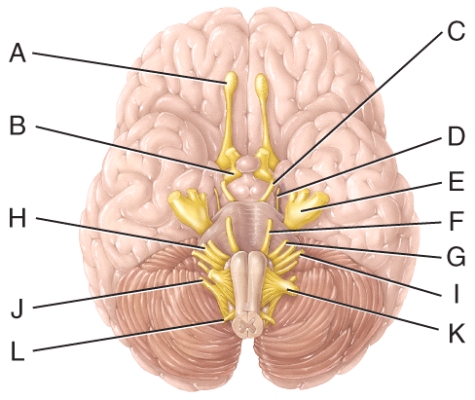
A)A
B)B
C)C
D)D
E)E

A)A
B)B
C)C
D)D
E)E

Unlock Deck
Unlock for access to all 72 flashcards in this deck.
Unlock Deck
k this deck
22
Describe the structural and functional relationship between the hypothalamus and the pituitary gland.

Unlock Deck
Unlock for access to all 72 flashcards in this deck.
Unlock Deck
k this deck
23
In this diagram injury to which area would affect sensory impulses reaching the cerebral cortex?
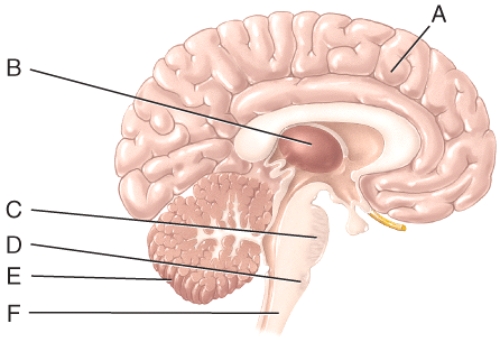
A)A
B)B
C)C
D)D
E)E

A)A
B)B
C)C
D)D
E)E

Unlock Deck
Unlock for access to all 72 flashcards in this deck.
Unlock Deck
k this deck
24
Infections may spread from the nasal cavity to the meninges along olfactory nerves.These fibers travel from the mucosa of the nasal cavity to the olfactory bulb through the
A)cribiform plate.
B)crista galli.
C)superior orbital fissue.
D)inferior oribital fissure.
E)optic foramen.
A)cribiform plate.
B)crista galli.
C)superior orbital fissue.
D)inferior oribital fissure.
E)optic foramen.

Unlock Deck
Unlock for access to all 72 flashcards in this deck.
Unlock Deck
k this deck
25
Which of the labeled structures in the diagram contains centers that control heart rate and blood pressure?
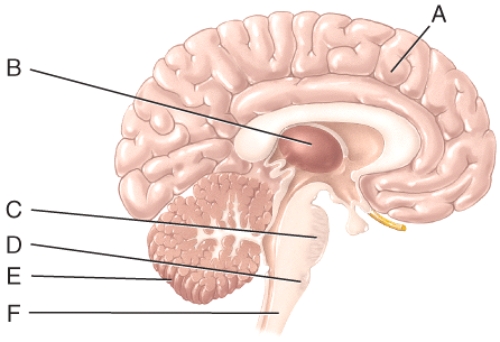
A)A
B)B
C)D
D)E
E)F

A)A
B)B
C)D
D)E
E)F

Unlock Deck
Unlock for access to all 72 flashcards in this deck.
Unlock Deck
k this deck
26
All of the cranial nerves listed exit the cranium by bony openings in front of the petrous portion.
A)trochlear
B)abducens
C)trigeminal
D)facial
E)oculomotor
A)trochlear
B)abducens
C)trigeminal
D)facial
E)oculomotor

Unlock Deck
Unlock for access to all 72 flashcards in this deck.
Unlock Deck
k this deck
27
In this diagram which major portion of the brain is used to monitor movements initiated by the motor areas of the cerebrum?
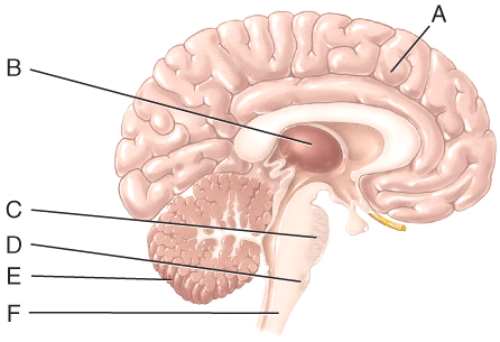
A)B
B)E
C)F
D)C
E)A

A)B
B)E
C)F
D)C
E)A

Unlock Deck
Unlock for access to all 72 flashcards in this deck.
Unlock Deck
k this deck
28
Which functional area of the cerebrum is responsible for the ability to form words?
A)Broca's area
B)Primary visual area
C)Common integrative area
D)Primary olfactory area
E)Primary somatosensory area
A)Broca's area
B)Primary visual area
C)Common integrative area
D)Primary olfactory area
E)Primary somatosensory area

Unlock Deck
Unlock for access to all 72 flashcards in this deck.
Unlock Deck
k this deck
29
Which functional area of the cerebrum is responsible for perception of touch,coldness and warmth?
A)Broca's area
B)Primary visual area
C)Common integrative area
D)Prefrontal cortex area
E)Primary somatosensory area
A)Broca's area
B)Primary visual area
C)Common integrative area
D)Prefrontal cortex area
E)Primary somatosensory area

Unlock Deck
Unlock for access to all 72 flashcards in this deck.
Unlock Deck
k this deck
30
Frontal lobe damage left an individual unable to speak.What area was specifically damaged?
A)Broca's area
B)Primary gustatory area
C)Common integrative area
D)Prefrontal cortex area
E)Wernicke's area
A)Broca's area
B)Primary gustatory area
C)Common integrative area
D)Prefrontal cortex area
E)Wernicke's area

Unlock Deck
Unlock for access to all 72 flashcards in this deck.
Unlock Deck
k this deck
31
Spinocerebellar tract axons carry sensory information into the cerebellum by the
A)Inferior cerebellar peduncle
B)Middle cerebellar peduncle
C)Superior cerebellar peduncle
D)Anterior lobe
E)Posterior lobe
A)Inferior cerebellar peduncle
B)Middle cerebellar peduncle
C)Superior cerebellar peduncle
D)Anterior lobe
E)Posterior lobe

Unlock Deck
Unlock for access to all 72 flashcards in this deck.
Unlock Deck
k this deck
32
In 1848,a railroad worker named Phineas Gage was seriously injured during an explosion on the job.A tapered metal rod ranging from 0.25 inches to 1.25 inches in diameter and over 3 feet long entered his skull just under his left cheek bone and exited through the top of his skull.The rod was found over twenty feet away.Amazingly,Gage lived even though he suffered massive damage to the left front of his brain.His personality and intellectual abilities changed,however.Before the accident,he was respected as a smart,capable and even-tempered man.After the accident,he was foul-mouthed and bad-tempered and could not make up his mind.In the years immediately preceding his death,he began to have epileptic seizures.Explain the changes observed in Mr.Gage based on your knowledge of the functional areas of the brain.

Unlock Deck
Unlock for access to all 72 flashcards in this deck.
Unlock Deck
k this deck
33
The pineal gland is located in the [dropdown 1] but the release of melatonin is controlled by the [dropdown 2] which is part of the [dropdown 3].
dropdown 1and dropdown 3 choices:
thalamus
hypothalamus
epithalamus
dropdown 2 choices:
suprachiasmatic nucleus
habenular nuclei
midline nucleus
reticular nucleus
dropdown 1and dropdown 3 choices:
thalamus
hypothalamus
epithalamus
dropdown 2 choices:
suprachiasmatic nucleus
habenular nuclei
midline nucleus
reticular nucleus

Unlock Deck
Unlock for access to all 72 flashcards in this deck.
Unlock Deck
k this deck
34
During brain development,the gyri of the cerebrum are formed because
A)the white matter enlarges faster than the overlying gray matter.
B)the cerebral cortex folds to fit within the cranium.
C)the tracts must be fully formed before gray matter can develop
D)the gray matter grows faster than the underlying white matter.
E)the oligodendrocytes cannot myelinate neurons quickly
A)the white matter enlarges faster than the overlying gray matter.
B)the cerebral cortex folds to fit within the cranium.
C)the tracts must be fully formed before gray matter can develop
D)the gray matter grows faster than the underlying white matter.
E)the oligodendrocytes cannot myelinate neurons quickly

Unlock Deck
Unlock for access to all 72 flashcards in this deck.
Unlock Deck
k this deck
35
Which of the following conducts nerve impulses between the two different hemispheres of the cerebrum?
A)Association tracts
B)Basal nuclei
C)Projection tracts
D)Septum pellucidum
E)Commissural tracts
A)Association tracts
B)Basal nuclei
C)Projection tracts
D)Septum pellucidum
E)Commissural tracts

Unlock Deck
Unlock for access to all 72 flashcards in this deck.
Unlock Deck
k this deck
36
Which cranial nerves control movements of the eyeball?
A)optic (II)nerve,oculomotor (III)nerve,and trochlear (IV)nerve
B)olfactory (I)nerve,trigeminal (V)nerve,and vagus (X)nerve
C)oculomotor (III)nerve,glossopharyngeal (IX)nerve,and trigeminal (V)nerve
D)oculomotor (III)nerve,trochlear (IV)nerve,and abducens (VI)nerve
E)vagus (X)nerve,accessory (XI)nerve,and hypoglossal (XII)nerve
A)optic (II)nerve,oculomotor (III)nerve,and trochlear (IV)nerve
B)olfactory (I)nerve,trigeminal (V)nerve,and vagus (X)nerve
C)oculomotor (III)nerve,glossopharyngeal (IX)nerve,and trigeminal (V)nerve
D)oculomotor (III)nerve,trochlear (IV)nerve,and abducens (VI)nerve
E)vagus (X)nerve,accessory (XI)nerve,and hypoglossal (XII)nerve

Unlock Deck
Unlock for access to all 72 flashcards in this deck.
Unlock Deck
k this deck
37
Arousal and attention are influenced by the [dropdown 1],that receives input from all sensory stimuli except [dropdown 2].
Dropdown 1 choices:
Reticular activating system
Substantia nigra
Superior colliculi
Inferior colliculi
Cerebral peduncles
Dropdown 2 choices
Olfactory
Gustatory
Visual
Auditory
Dropdown 1 choices:
Reticular activating system
Substantia nigra
Superior colliculi
Inferior colliculi
Cerebral peduncles
Dropdown 2 choices
Olfactory
Gustatory
Visual
Auditory

Unlock Deck
Unlock for access to all 72 flashcards in this deck.
Unlock Deck
k this deck
38
A baseball player is hit by a line drive on the temporal area of his skull.At the hospital the doctors give a CT scan which shows an accumulation of blood between the dura mater and arachnoid mater,creating pressure on the cerebrum.The hemorrhage from the fracture would be located in which space?
A)epidural space
B)subdural space
C)subarachnoid space
D)nasal sinus
E)straight sinus
A)epidural space
B)subdural space
C)subarachnoid space
D)nasal sinus
E)straight sinus

Unlock Deck
Unlock for access to all 72 flashcards in this deck.
Unlock Deck
k this deck
39
Damaging which cranial nerve could decrease gastrointestinal secretions?
A)Oculomotor
B)Trigeminal
C)Spinal accessory
D)Facial
E)Vagus
A)Oculomotor
B)Trigeminal
C)Spinal accessory
D)Facial
E)Vagus

Unlock Deck
Unlock for access to all 72 flashcards in this deck.
Unlock Deck
k this deck
40
Which region of the brain is separated by the third ventricle and projects most sensory information to the cerebral cortex from the spinal cord and brain stem?
A)Thalamus
B)Hypothalamus
C)Epithalamus
D)Pons
E)Midbrain
A)Thalamus
B)Hypothalamus
C)Epithalamus
D)Pons
E)Midbrain

Unlock Deck
Unlock for access to all 72 flashcards in this deck.
Unlock Deck
k this deck
41
Hand preference when writing or throwing is an example of
A)cranial nerve damage.
B)hemispheric lateralization.
C)damage to the olfactory nerve.
D)damage to Broca's area.
A)cranial nerve damage.
B)hemispheric lateralization.
C)damage to the olfactory nerve.
D)damage to Broca's area.

Unlock Deck
Unlock for access to all 72 flashcards in this deck.
Unlock Deck
k this deck
42
Which cranial nerve in the diagram is involved with speech and swallowing and has a purely motor function?
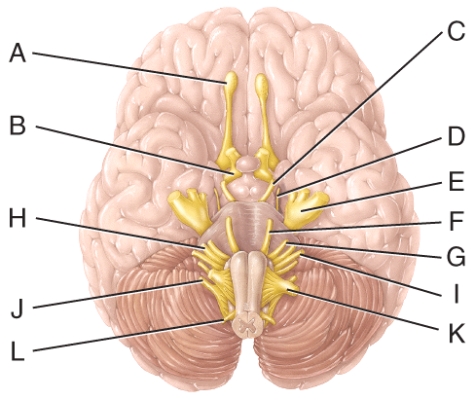
A)H
B)I
C)J
D)K
E)L

A)H
B)I
C)J
D)K
E)L

Unlock Deck
Unlock for access to all 72 flashcards in this deck.
Unlock Deck
k this deck
43
Facial movement is primarily controlled by ____nerve,while sensation from the face is primarily determined by ____nerve.
A)facial;trigeminal
B)trigeminal;facial
C)glossopharyngeal;trigeminal
D)glossopharyngeal;facial
E)accessory;facial
A)facial;trigeminal
B)trigeminal;facial
C)glossopharyngeal;trigeminal
D)glossopharyngeal;facial
E)accessory;facial

Unlock Deck
Unlock for access to all 72 flashcards in this deck.
Unlock Deck
k this deck
44
Which type of brain wave occurs at regular intervals when a person is awake but not when a person is sleeping?
A)Alpha waves
B)Beta waves
C)Theta waves
D)Delta waves.
E)All of the selections are correct
A)Alpha waves
B)Beta waves
C)Theta waves
D)Delta waves.
E)All of the selections are correct

Unlock Deck
Unlock for access to all 72 flashcards in this deck.
Unlock Deck
k this deck
45
During a firework celebration,a firework exploded next to a technician's ear,resulting in hearing loss.What nerve was damaged?
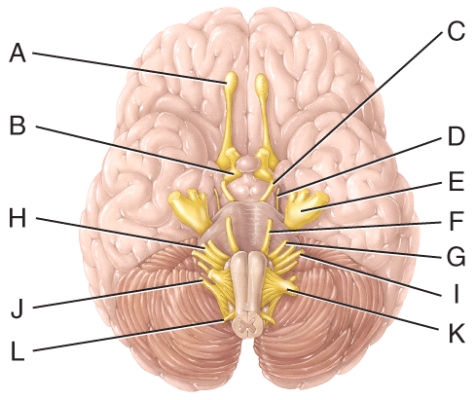
A)E
B)G
C)H
D)I
E)J

A)E
B)G
C)H
D)I
E)J

Unlock Deck
Unlock for access to all 72 flashcards in this deck.
Unlock Deck
k this deck
46
Damage to which cranial nerve may result in death?
A)glossopharyngeal
B)vagus
C)vestibulocochlear
D)oculomotor
E)facial
A)glossopharyngeal
B)vagus
C)vestibulocochlear
D)oculomotor
E)facial

Unlock Deck
Unlock for access to all 72 flashcards in this deck.
Unlock Deck
k this deck
47
Left side face paralysis could result from damage to which nerve in the diagram?
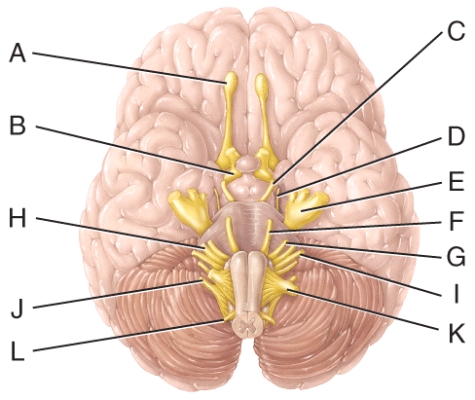
A)C
B)D
C)E
D)F
E)G

A)C
B)D
C)E
D)F
E)G

Unlock Deck
Unlock for access to all 72 flashcards in this deck.
Unlock Deck
k this deck
48
An electroencephalogram (EEG)measures brain waves primarily generated by
A)neurons in the pons.
B)neurons in the medulla oblongata.
C)neurons in the thalamus.
D)neurons in the cerebral cortex.
E)neurons in the cerebellum.
A)neurons in the pons.
B)neurons in the medulla oblongata.
C)neurons in the thalamus.
D)neurons in the cerebral cortex.
E)neurons in the cerebellum.

Unlock Deck
Unlock for access to all 72 flashcards in this deck.
Unlock Deck
k this deck
49
The maxillary branch of which cranial nerve in the diagram would be anesthetized by dentists for upper jaw work?

A)E
B)G
C)H
D)I
E)J

A)E
B)G
C)H
D)I
E)J

Unlock Deck
Unlock for access to all 72 flashcards in this deck.
Unlock Deck
k this deck
50
Which lobe of the cerebrum is found deep to the other four lobes and thus cannot be observed from the surface?
A)occipital
B)temporal
C)parietal
D)insula
E)frontal
A)occipital
B)temporal
C)parietal
D)insula
E)frontal

Unlock Deck
Unlock for access to all 72 flashcards in this deck.
Unlock Deck
k this deck
51
Which are areas of gray matter found in each cerebral hemisphere that are important in helping to control the initiation and termination of skeletal muscle movements?
A)red nuclei
B)vestibular nuclei
C)lateral olivary nuclei
D)basal nuclei
E)substantia nigra
A)red nuclei
B)vestibular nuclei
C)lateral olivary nuclei
D)basal nuclei
E)substantia nigra

Unlock Deck
Unlock for access to all 72 flashcards in this deck.
Unlock Deck
k this deck
52
Blood flows to the brain through the _____ arteries and away from the brain through the _____ veins.
A)internal carotid and vertebral;internal jugular
B)external carotid and vertebral;external jugular
C)internal jugular and vertebral;internal carotid
D)internal carotid and axillary;internal jugular
E)external jugular and axillary;external jugular
A)internal carotid and vertebral;internal jugular
B)external carotid and vertebral;external jugular
C)internal jugular and vertebral;internal carotid
D)internal carotid and axillary;internal jugular
E)external jugular and axillary;external jugular

Unlock Deck
Unlock for access to all 72 flashcards in this deck.
Unlock Deck
k this deck
53
Which cranial nerve in the diagram has a somatic motor function primarily involved in moving the upper eyelid and eyeball and an autonomic function involved in iris muscle contraction?
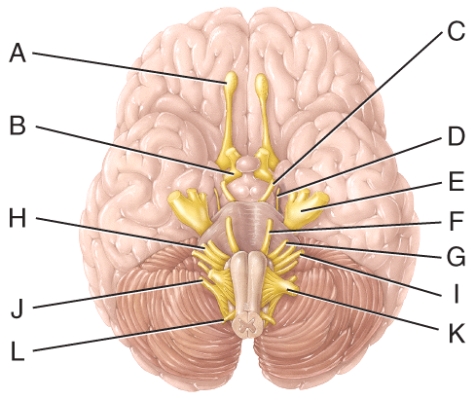
A)A
B)B
C)C
D)D
E)F

A)A
B)B
C)C
D)D
E)F

Unlock Deck
Unlock for access to all 72 flashcards in this deck.
Unlock Deck
k this deck
54
Damage to this nucleus would affect input from the limbic system,superior colliculi and cerebral cortex affecting the ability to express emotions.
A)lateral geniculate nucleus
B)medial geniculate nucleus
C)ventral posterior nucleus
D)lateral dorsal nucleus -
E)ventral lateral nucleus
A)lateral geniculate nucleus
B)medial geniculate nucleus
C)ventral posterior nucleus
D)lateral dorsal nucleus -
E)ventral lateral nucleus

Unlock Deck
Unlock for access to all 72 flashcards in this deck.
Unlock Deck
k this deck
55
The central sulcus of the cerebrum separates the_____,and the lateral fissure separates the _____.
A)two cerebral hemispheres;frontal lobe from parietal lobe
B)frontal lobe from the parietal lobe;temporal lobe from frontal lobe
C)frontal lobe from the temporal lobe;occipital lobe from parietal lobe
D)parietal lobe from the temporal lobe;parietal lobe from frontal lobe
E)temporal lobe from the occipital lobe;temporal lobe from parietal lobe
A)two cerebral hemispheres;frontal lobe from parietal lobe
B)frontal lobe from the parietal lobe;temporal lobe from frontal lobe
C)frontal lobe from the temporal lobe;occipital lobe from parietal lobe
D)parietal lobe from the temporal lobe;parietal lobe from frontal lobe
E)temporal lobe from the occipital lobe;temporal lobe from parietal lobe

Unlock Deck
Unlock for access to all 72 flashcards in this deck.
Unlock Deck
k this deck
56
Brain waves that generally appear during periods of sensory input and mental activity are called
A)alpha waves.
B)beta waves.
C)theta waves.
D)delta waves.
E)P waves.
A)alpha waves.
B)beta waves.
C)theta waves.
D)delta waves.
E)P waves.

Unlock Deck
Unlock for access to all 72 flashcards in this deck.
Unlock Deck
k this deck
57
Which of the following statements best describes the structure of the blood-brain barrier that provides its functional characteristics?
A)Processes of astrocytes wrap tightly around capillaries in the brain.
B)Tight junctions tightly seal endothelial cells of capillaries in the brain.
C)Gap junctions tightly seal endothelial cells of capillaries in the brain.
D)Spot desmosomes tightly link capillary endothelial cells together.
E)The basement membrane of capillaries in the brain contains extremely small pores.
A)Processes of astrocytes wrap tightly around capillaries in the brain.
B)Tight junctions tightly seal endothelial cells of capillaries in the brain.
C)Gap junctions tightly seal endothelial cells of capillaries in the brain.
D)Spot desmosomes tightly link capillary endothelial cells together.
E)The basement membrane of capillaries in the brain contains extremely small pores.

Unlock Deck
Unlock for access to all 72 flashcards in this deck.
Unlock Deck
k this deck
58
Brain waves that appear during deep sleep are called
A)alpha waves.
B)beta waves.
C)theta waves.
D)delta waves.
E)P waves.
A)alpha waves.
B)beta waves.
C)theta waves.
D)delta waves.
E)P waves.

Unlock Deck
Unlock for access to all 72 flashcards in this deck.
Unlock Deck
k this deck
59
Damage to which cranial nerve in the diagram will cause the inability of an eyeball to move laterally beyond the midpoint?
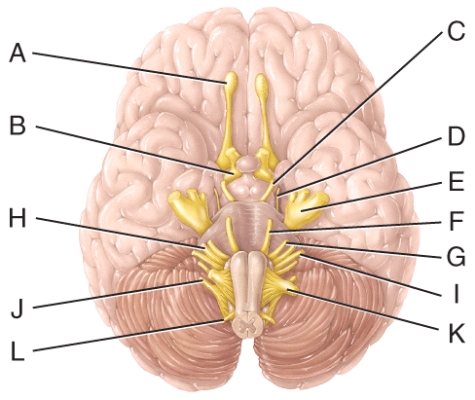
A)B
B)C
C)D
D)E
E)F

A)B
B)C
C)D
D)E
E)F

Unlock Deck
Unlock for access to all 72 flashcards in this deck.
Unlock Deck
k this deck
60
A patient shows no effect when a light shines in the right eye,but shining a light into the left eye causes both pupils (right and left)to constrict.This could be caused by a lesion on the ______ nerve.
A)optic
B)trochlear
C)trigeminal
D)facial
A)optic
B)trochlear
C)trigeminal
D)facial

Unlock Deck
Unlock for access to all 72 flashcards in this deck.
Unlock Deck
k this deck
61
A patient with Wernicke's aphasia would exhibit what issues upon examination?
A)Slow,non-fluent speech devoid of meaning
B)Can understand what is being said,but unable to repeat the words
C)Difficulty pronouncing multisyllabic words
D)No expression of fear or emotions
E)Unable to recognize faces
A)Slow,non-fluent speech devoid of meaning
B)Can understand what is being said,but unable to repeat the words
C)Difficulty pronouncing multisyllabic words
D)No expression of fear or emotions
E)Unable to recognize faces

Unlock Deck
Unlock for access to all 72 flashcards in this deck.
Unlock Deck
k this deck
62
An infant has hydrocephalus.The CSF could not get out of the third ventricle.What passage was blocked ?
A)central canal
B)aqueduct of midbrain
C)interventricular foramen
D)lateral aperture
E)median aperture
A)central canal
B)aqueduct of midbrain
C)interventricular foramen
D)lateral aperture
E)median aperture

Unlock Deck
Unlock for access to all 72 flashcards in this deck.
Unlock Deck
k this deck
63
The left cerebellar hemisphere receives information from the ___cerebral hemisphere.This type of input is considered _____.
A)Right;ipsilateral
B)Right contralateral
C)Left;ipsilateral
D)Left;contralateral
A)Right;ipsilateral
B)Right contralateral
C)Left;ipsilateral
D)Left;contralateral

Unlock Deck
Unlock for access to all 72 flashcards in this deck.
Unlock Deck
k this deck
64
A child riding a bike falls and hits their head.The child was not wearing a helmet.In the emergency room,cerebrospinal fluid taken during a spinal tap reveals blood.The doctors diagnosed the child had torn cerebral veins as they pass to the superior sagittal sinus.What area of the body was the fluid taken?
A)Epidural space
B)Subarachnoid space
C)Subdural space
D)Superior sagittal sinus
E)Lateral ventricles
A)Epidural space
B)Subarachnoid space
C)Subdural space
D)Superior sagittal sinus
E)Lateral ventricles

Unlock Deck
Unlock for access to all 72 flashcards in this deck.
Unlock Deck
k this deck
65
Eating disorders may lead to extreme thirst and temperature variations.These symptoms may describe a dysfunction in the
A)Thalamus
B)Medulla oblongata
C)Hypothalamus
D)Pons
E)Tectum
A)Thalamus
B)Medulla oblongata
C)Hypothalamus
D)Pons
E)Tectum

Unlock Deck
Unlock for access to all 72 flashcards in this deck.
Unlock Deck
k this deck
66
Blockage of cerebrospinal fluid within the aqueduct of midbrain would result in the swelling of all ventricular spaces EXCEPT the
A)Lateral ventricle
B)Third ventricle
C)Fourth ventricle
D)Interventricular foramen
E)Right and left ventricles
A)Lateral ventricle
B)Third ventricle
C)Fourth ventricle
D)Interventricular foramen
E)Right and left ventricles

Unlock Deck
Unlock for access to all 72 flashcards in this deck.
Unlock Deck
k this deck
67
Which cranial nerve is associated with nuclei in both the medulla oblongata and pons?
A)V
B)VI
C)VII
D)VIII
E)IX
A)V
B)VI
C)VII
D)VIII
E)IX

Unlock Deck
Unlock for access to all 72 flashcards in this deck.
Unlock Deck
k this deck
68
Damage to which portion of the limbic system results in loss of memory of recent events and difficulty committing anything new to memory?
A)amygdala
B)dentate gyrus
C)cingulate gyrus
D)hippocampus
E)septal nuclei
A)amygdala
B)dentate gyrus
C)cingulate gyrus
D)hippocampus
E)septal nuclei

Unlock Deck
Unlock for access to all 72 flashcards in this deck.
Unlock Deck
k this deck
69
An individual cannot feel tactile sensation on the right side of the face.A lesion could be in which brainstem region?
A)Medulla oblongata
B)Pons
C)Midbrain
D)Tectum
A)Medulla oblongata
B)Pons
C)Midbrain
D)Tectum

Unlock Deck
Unlock for access to all 72 flashcards in this deck.
Unlock Deck
k this deck
70
The midbrain contains nuclei associated with cranial nerves [dropdown 1] and the pons contains nuclei associated with cranial nerves [dropdown 2].
Dropdown Choices:
II and III
III and IV
IV,V,VI
V,VI,VII,VIII
VI,VII,VIII
VII ,X,XII
VIII,IX,X,XI
Dropdown Choices:
II and III
III and IV
IV,V,VI
V,VI,VII,VIII
VI,VII,VIII
VII ,X,XII
VIII,IX,X,XI

Unlock Deck
Unlock for access to all 72 flashcards in this deck.
Unlock Deck
k this deck
71
A common type of disabling senile dementia that results in progressive loss of intellectual ability,is called
A)agnosia.
B)prosopagnosia.
C)Alzheimer disease.
D)transient ischemic attack syndrome.
E)amylotrophic lateral sclerosis.
A)agnosia.
B)prosopagnosia.
C)Alzheimer disease.
D)transient ischemic attack syndrome.
E)amylotrophic lateral sclerosis.

Unlock Deck
Unlock for access to all 72 flashcards in this deck.
Unlock Deck
k this deck
72
A boy has been reported to lack fear and not show any stress in dangerous situations.These symptoms suggest issues with which area of the brain?
A)Parietal lobe
B)Frontal lobe
C)Occipital lobe
D)Amygdala
E)Midbrain
A)Parietal lobe
B)Frontal lobe
C)Occipital lobe
D)Amygdala
E)Midbrain

Unlock Deck
Unlock for access to all 72 flashcards in this deck.
Unlock Deck
k this deck



